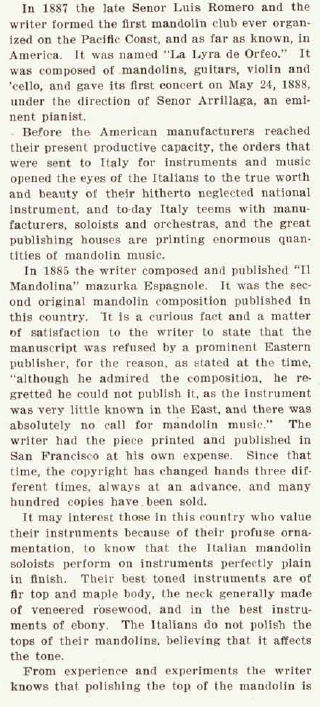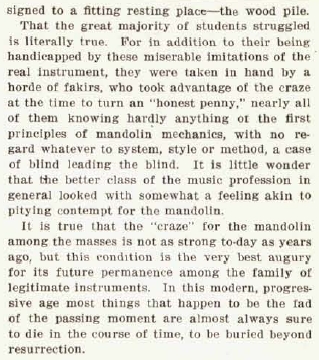| Music Trade Review |
|
Die Zeitschrift Music Trade Review ist online verfügbar: |
|
Music Trade Review - Music
Industry Magazine
Online Library: 1880 - 1933, 1940-1954 The Music Trade Review was published out of New York from 1878 until at least 1956. It apparently suspended publication with the January 1933 issue. Publication was resumed under different management sometime between 1937 and 1940. Our online library contains issues from 1880 to 1933, and from 1940 to 1954. Additional years are available for review at a number of libraries. Search www.worldcat.org for more information about the holdings of other libraries, or ask your local librarian for assistance. |
| |
| --
google Anzeige -- |
| Bitte
teilen sie diese Seite: |
|
|
 |
 |
THE EVOLUTION OF THE MANDOLIN IN THE UNITED STATESBy Samuel Adelstein, Composer and Teacher, San Francisco, Cal.During the past 25 years no musical instrument has advanced so rapidly in Europe and in this country as the Neapolitan mandolin. In Germany and in England, where a few years ago the instrument was virtually unknown, and in Paris only in a very modest way, to-day the mandolin is played by thousands. Titled amateurs give it prominence in their exclusive drawingroom musicales and receptions. Italy is the home of the mandolin. It is the chosen and national instrument of the people. It is a curious fact that up to 30 years ago the mandolin was only played in a desultory manner in Italy. To the pioneer mandolinists of San Francisco can be clearly traced the beginning and marvelous growth of the mandolin. The mandolin was introduced into this country, and particularly San Francisco, by the Original Spanish Students, who appeared here about 26 years ago at the old Winter Garden. Those who heard this marvelous organization will never forget the splendid ensemble playing and the exquisite effects, nor the quaint and curious costumes, like the wandering minstrels of old, with doublet and hose and the large silver spoon always prominently in their headgear. Manuel Y. Ferrer, the late eminent guitarist and composer, and Luis Romero, the late gifted guitar soloist, and the writer, were the three original mandolinists and teachers of the instrument on the Pacific Coast. At that time (20 years ago) there was absolutely no music published for the mandolin in this country, no manufacturers of instruments, and in comparison to the population, few or hardly any teachers east of the Rocky Mountains, excepting a few Italians in New York, amateurs in the Latin quarter, who played the mandolin for pastime among themselves. In 1887 the late Senor Luis Romero and the writer formed the first mandolin club ever organized on the Pacific Coast, and as far as known, in America. It was named "La Lyra de Orfeo." It was composed of mandolins, guitars, violin and 'cello, and gave its first concert on May 24, 1888, under the direction of Senor Arrillaga, an eminent pianist. Before the American manufacturers reached their present productive capacity, the orders that were sent to Italy for instruments and music opened the eyes of the Italians to the true worth and beauty of their hitherto neglected national instrument, and today Italy teems with manufacturers, soloists and orchestras, and the great publishing houses are printing enormous quantities of mandolin music. In 1885 the writer composed and published "II Mandolina" mazurka Espagnole. It was the second original mandolin composition published in this country. It is a curious fact and a matter of satisfaction to the writer to state that the manuscript was refused by a prominent Eastern publisher, for the reason, as stated at the time, "although he admired the composition, he regretted he could not publish it, as the instrument was very little known in the East, and there was absolutely no call for mandolin music." The writer had the piece printed and published in San Francisco at his own expense. Since that time, the copyright has changed hands three different times, always at an advance, and many hundred copies have been sold. It may interest those in this country who value their instruments because of their profuse ornamentation, to know that the Italian mandolin soloists perform on instruments perfectly plain in finish. Their best toned instruments are of fir top and maple body, the neck generally made of veneered rosewood, and in the best instruments of ebony. The Italians do not polish the tops of their mandolins, believing that it affects the tone. From experience and experiments the writer knows that polishing the top. of the mandolin is the most fatal defect in all American instruments. Superfluous additions, however they may be pleasing to the eye, most seriously affect the tonal quality of the mandolin. If the manufacturers who take so much pains in ornamentation, etc., would be more judicious in the careful selection and take more time in the slow seasoning of the wood, and pay more attention to the joining and finishing, there would be less complaint of absence of tone and the resulting benefit would be of inestimable value for the reputation and standing of the tonal quality of the mandolin in the musical world in America. Within the past four or five years it has been repeatedly asked, "Is the power and popularity of the mandolin waning?" Manufacturers and dealers have been complaining that the number of mandolins sold has decreased considerably from that of ten years ago. Instruments were turned out in gross lot, like furniture. Mandolins with striped bodies (like the zebra), of different colored stained woods, hardly seasoned at all, inlaid with a lot of cheap, tawdry "ginger-bread" inlaying of so-called "mother of pearl" (the poorest quality of abalone shell), flowers, flying birds, etc., etc., with brass and tin patent heads that were constantly wearing out; instruments that had as much real mandolin quality of tone as an empty tomato can with strings strung across its top. With a few weeks playing these monstrosities would warp at the neck, the top would "buckle" or sink in, the frets would loosen, the keys rattle, and then the student in disgust would give up, and his suffering family and friends who had been obliged to listen to an instrument that sounded like a cross between a Japanese tom-tom and a Chinese fiddle, would breathe a sigh of relief that the thing had at last been consigned to a fitting resting place—the wood pile. That the great majority of students struggled is literally true. For in addition to their being handicapped by these miserable imitations of the real instrument, they were taken in hand by a horde of fakirs, who took advantage of the craze at the time to turn an "honest penny," nearly all of them knowing hardly anything ot the first principles of mandolin mechanics, with no regard whatever to system, style or method, a case of blind leading the blind. It is little wonder that tiie better class of the music profession in general looked with somewhat a feeling akin to pitying contempt for the mandolin. It is true that the "craze" for the mandolin among the masses is not as strong to-day as years ago, but this condition is the very best augury for its future permanence among the family of legitimate instruments. In this modern, progressive age most things that happen to be the fad of the passing moment are almost always sure to die in the course of time, to be buried beyond resurrection. |
|
|
|
|
|
|
FOURTH ANNUAL CONVENTIONOf Mandolinists, Banjoists and Guitarists Be Held in Boston, March 29.(Special to The Review.) The American Guild of Mandolin, Banjoists and Guitarists will hold its forth annual convention and festival concert in this city, in the new Jordan Hall, at the New England Conservatory of Music, March 29, 1905. The artists for the concert are Sig. Guiseppe Pettine, mandolin soloist; Mr. Lansing, banjo soloist; H. F. Odell, mandolin soloist; Boston Ideal Club, the Langham Mandolin Orchestra, the Lansing Mandolin Orchestra and an enlarged orchestra of two hundred banjoists, mandolinists and guitarists which will be accompanied by the grand organ (one of the largest in the country), at the hall. Assurances have been received from teachers all over New England, New York and Philadelphia that they will attend the concert and convention, and the affair promises to be very successful in every respect. In connection with this affair the committee in charge are preparing a souvenir programme. |
| Wenn
sie diese Seite
ohne Navigationsleiste angezeigt bekommen, dann klicken sie hier um die MandoIsland Homepage zu öffen: |
 |